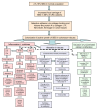The association of Streptococcus bovis/gallolyticus with colorectal tumors: the nature and the underlying mechanisms of its etiological role
- PMID: 21247505
- PMCID: PMC3032743
- DOI: 10.1186/1756-9966-30-11
The association of Streptococcus bovis/gallolyticus with colorectal tumors: the nature and the underlying mechanisms of its etiological role
Abstract
Streptococcus bovis (S. bovis) bacteria are associated with colorectal cancer and adenoma. S. bovis is currently named S. gallolyticus. 25 to 80% of patients with S. bovis/gallolyticus bacteremia have concomitant colorectal tumors. Colonic neoplasia may arise years after the presentation of bacteremia or infectious endocarditis of S. bovis/gallolyticus. The presence of S. bovis/gallolyticus bacteremia and/or endocarditis is also related to the presence of villous or tubular-villous adenomas in the large intestine. In addition, serological relationship of S. gallolyticus with colorectal tumors and direct colonization of S. gallolyticus in tissues of colorectal tumors were found. However, this association is still under controversy and has long been underestimated. Moreover, the etiological versus non-etiological nature of this associationis not settled yet. Therefore, by covering the most of up to date studies, this review attempts to clarify the nature and the core of S. bovis/gallolyicus association with colorectal tumors and analyze the possible underlying mechanisms.
Figures
References
-
- Kok H, Jureen R, Soon CY, Tey BH. Colon cancer presenting as Streptococcus gallolyticus infective endocarditis. Singapore Med J. 2007;48:e43–45. - PubMed
Publication types
MeSH terms
LinkOut - more resources
Full Text Sources
Medical


